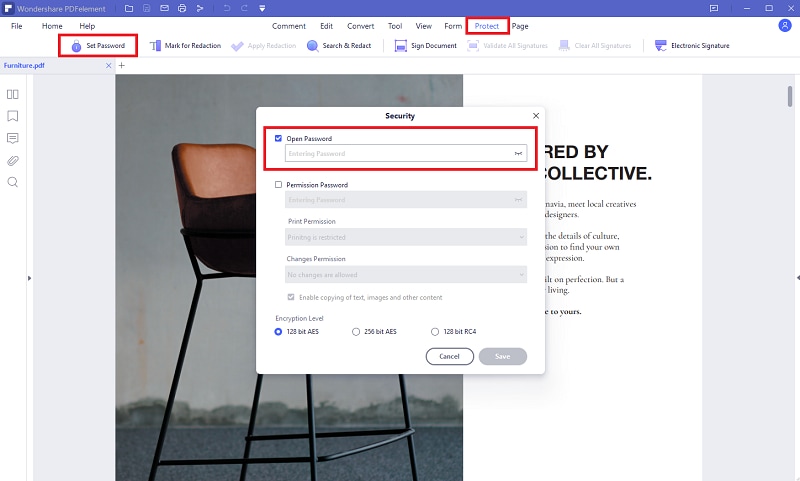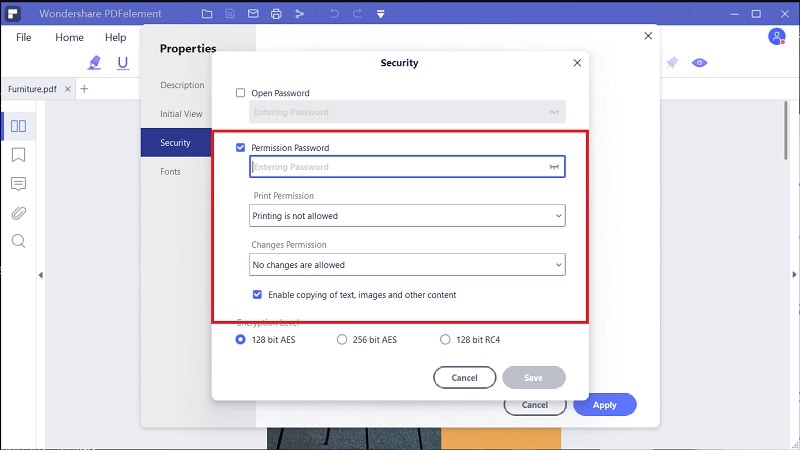How to Put a Password on PDF Easily
• Filed to: PDF Security
Sometimes PDF files include sensitive and highly confidential data that you would want to put a password on a PDF file. For instance, if there is a document about a personal financial statement, a company's balance sheet, or a tax statement, you wouldn't want anyone to see them or use them without permission. So, how to put a password on a PDF?
Well, you can easily put a password on a PDF document using PDFelement Pro. Once you add a password, even if someone downloaded your PDF, they’ll have to put a password to open and see the content of the file.
The Simplest Way to Put a Password on PDF
PDFelement is an all-in-one PDF tool that allows you to encrypt PDF files with an Open password and Permission password in a pretty straightforward manner. Moreover, PDFelement is bundled with useful PDF features, can do much more including create, annotations, ORC, fill the form, edit text, merge, convert, and many other tasks. And if you want to remove PDF password when you have put it on your PDF document, PDFelement can help you do so.
In this article, we will walk you through how to put a password on a PDF:
Step 1: Open PDF file
To password protect a PDF file; first, download a PDFelement on your Windows or Mac. Launch the program, on the home window click on the 'Open Files' option, and select the confidential PDF file you wish to protect or drag-and-drop the PDF into the software workspace.

Step 2: Put a Password on PDF
On the main menu, click on the 'Protect' button shown on the right. Now on the submenu that comes up, click on 'Set Password'. A pop-up window will appear that allows you to set two types of protection; Open password and Permission password to the file. Open Password is set to restrain a person from opening a file and accessing it whereas Protect Password allows you to set a limit on certain features, such as printing, copying, deleting, modifying, and all.

Step 3: Put an Open Password on PDF
To put the Open Password on the selected PDF document, tick on the 'Open Password' checkbox. Enter the password and here you can set the type of encryption level that you wish. PDFelement gives you three levels of encryption: 128-bit AES, 256-bit AES, and 128-bit RC4 with Open Password. After choosing the encryption level that you want, click the 'Save' button. Now the password will appear on the PDF element and a user is required to type a password to open the PDF.

Step 4: Put permission password to PDF
You can put a Permission Password to a PDF file as well. Again, with the permission password on PDFelement, there are three levels of encryption as mentioned above. To put the permission password, tick on the 'Permission Password' box. Now, you can set Print Permission and the 'Changes Permission' option as per the requirement. You can restrict others from printing the document, changing, inserting, deleting, commenting, filling, or signing the document, and much more.
Make sure to tick the enabled copying of texts, images, and content so that this change can be implemented on the entire content of the file. Further, select the encryption level and click on 'Save' to put a permission password on the PDF document. Now the user will need a password to change the restrictions you've set.

Step 5: Save PDF with Password
Once you have successfully put the open password and permission password on the PDF file document, permanently save the password and other restriction changes. To do it, click on the save icon on the Quick Access Toolbar or go to the main menu, click on the 'File' option, and hit the 'Save' option. Finally, the password-protected file is saved.
If you have secured the PDF with both passwords, the PDF can be opened or accessed with respective passwords. For added security, you can both types of passwords. Do remember the password, or make sure to save the password in a secure and safe place.
Key features of PDFelement:
- PDFelement is a versatile PDF editor that extends a full range of functionality for converting documents into multiple formats, edit content, OCR scan a document, add annotations, insert digital signatures, and much more.
- It allows you to add, remove, resize, move, as well as rotate graphical elements present in a PDF.
- Create, edit, add and fill PDF forms with ease. And lets you automatically save your PDF documents to the cloud services, such as Google Drive and Dropbox.
- It is compatible with all platforms Windows and Mac and its mobile app is available on both iOS and Android devices.





Ivan Cook
chief Editor